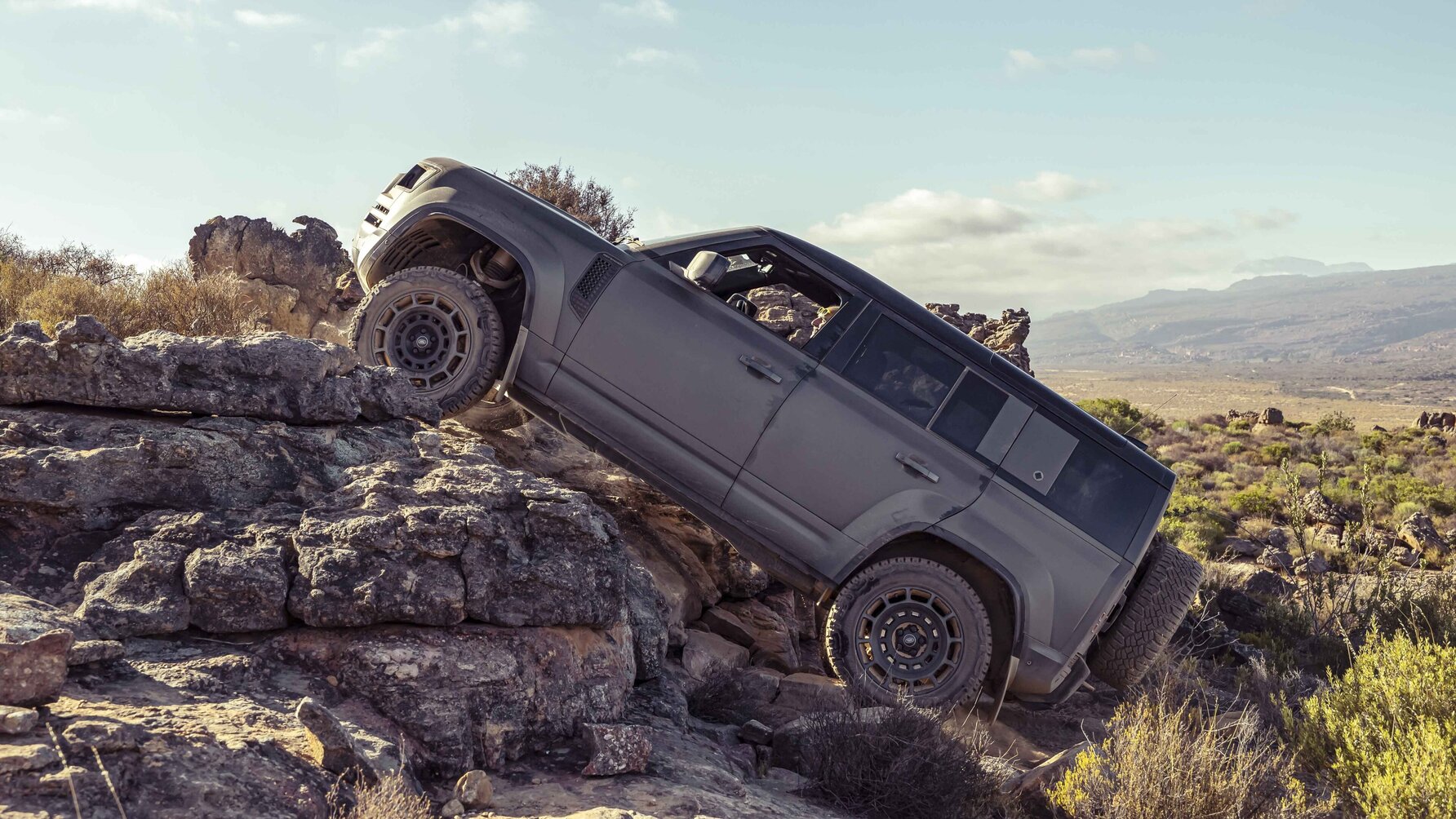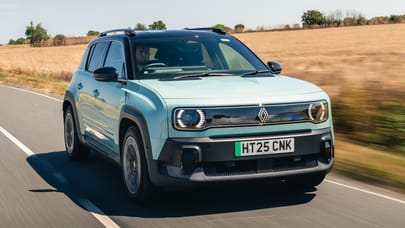
Diamond in the rough: desert driving in the Land Rover Defender Octa
The Octa is the biggest, baddest version of the Defender yet – conquering the South African wilderness should be a walk in the park
It sounds sacrilegious, but some of us reckon Sterrato might be the best Lamborghini ever. Super slidy, looks great, can take lots of punishment. Likewise the Porsche 911 Dakar. Sure, the limit is much lower than in racier 911s, but life’s easier when you get there. It’s an interesting direction of travel.
The Land Rover Defender Octa is on a similar trajectory but arrives from the opposite end of the spectrum. The mission statement here is to create the world’s fastest off-roader. Trying to define that is like nailing jelly to a wall, and a Nürburgring lap time isn’t going to tell the whole story. It’s about bandwidth, creating something that can do preposterous things off-road while also behaving in normal conditions.
So Octa is the answer to a disparate bunch of formerly rather niche questions. A dune bashing, quasi Dakar rally raider disguised as a long distance family hauler. A rock crawler that can also drift with mindless abandon. Celebratory, too. With the Land Rover name now parked in the basement as the company bigs up individual model brands, Defender has been an enormo-hit since it arrived in 2019.
Its much-loved but antiquated predecessor was shifting 12,000 units per year at the end, the current model is doing those numbers every month. The business case initially assumed 55,000 annual global sales, so double that plus all those highly specced Range Rovers equals heady profit.
Now here’s the flagship. The Octa has been three years in the making, is extensively reengineered (13,960 additional tests were carried out), and lands costing £161k. Sheesh. Is it worth it? We’re in South Africa to find out, and the full gamut of challenges await. So much so that it’s quite possible we could kill this new car.
About the name: Octa takes its inspiration from the diamond, octahedral in shape, equal parts beautiful and tough. It’s also something LR could register in 175 territories without fear of legal entanglements. Maybe SV just wasn’t distinctive enough.
Looks good, huh. Age and familiarity haven’t withered the Defender’s design, though the controversial “square of despair” is still there. In Octa guise, it rides 28mm higher than the regular car and is 68mm wider overall, with muscular wheelarch extensions. The design team has resisted the temptation to fully “murder out” the Defender, to the point that it’s about as subtle as a huge high performance SUV could ever be.
The First Edition cars are painted a new colour, Faroe Green, and there are fresh copper and grey shades. It’s rather military in look and feel, all the more so if the optional matte protective film is present. The only frippery is the chopped carbon fibre on the bonnet, flanks and seats.
Most of the changes enhance the Defender’s already formidable fitness for purpose. The front and rear axles have been moved forwards (by 4mm and 3mm) to fit the bigger tyres and manage the extra ride height. There’s a larger intake at the front to cope with the new engine’s hungrier cooling requirements, and a powder-coated metal undershield for extra protection.
The rear gets something similar. An extended bar behind the shield provides cover for a pair of auxiliary radiators, and there’s an undertray made of a tough composite. Thermal management was key. There’s also a heat shield around the fuel tank and triple insulated fuel lines. In fact, there’s about 12 miles of piping on this thing. Wheel articulation in its most extreme setting is up 100mm to 500mm, and its approach, departure and breakover angles are all improved.
Top Gear
Newsletter
Thank you for subscribing to our newsletter. Look out for your regular round-up of news, reviews and offers in your inbox.
Get all the latest news, reviews and exclusives, direct to your inbox.
Few cars sit as solidly on the road as this, or make for a more intimidating convoy. Lesser traffic quivers in our wake. Exiting Cape Town and heading towards the Cederberg mountains brings an immediate surprise, though. Where the old supercharged 5.0-litre V8 was a bit of a party animal – like John Belushi in Animal House – the new and more emissions-friendly 4.4-litre twin turbo with mild hybrid feels surprisingly restrained. There’s 626bhp and 553lb ft available here but it’s not all up in your face.
It’s a BMW unit but receives a number of model-specific modifications, including a reinforced cradle for the transmission and a new oil sump. There are unique propshafts, larger diameter driveshafts and reinforced joints. The engineers have even introduced high tensile steel in the rear differential because the Octa generates a substantially higher amount of axle torque. The ZF eight speed box is familiar, mated to a selectable high and low transfer case.
It’s in the V8 job description that it must emit a sound like rolling thunder under load. So the Octa has a bespoke quad pipe exhaust system whose back pressure has been finessed to optimise performance without hurting its ability to wade. In fact, it can cope with up to one metre of water, more than any previous Defender.
Yet the prevailing soundtrack in regular mode is a distant tyre rumble, not least because our car is running the optional Goodyear DuraTrac Advanced All Terrain rubber. That’s essential because we’ll be driving the Octa in a variety of bruising contexts. They look suitably chunky on the Octa’s understated new 20in alloy wheel, and are the largest tyres yet fitted to the Defender.
Their three ply construction improves the strength of the sidewall, but they’re speed restricted to 100mph (112mph in North America). More importantly, they also compromise on road handling, though not by much according to JLR’s vehicle attributes guru, former Lotus and Aston Martin man Matt Becker. Most Octas will end up running the Michelin all season tyres on 22in alloys.
One short push on the rather cheap looking Octa button on the lower part of the steering wheel takes us into Dynamic mode. This perks things up considerably. Steering, throttle, suspension and exhaust note all get more alert and responsive. But the secret sauce here arrives via the ‘6D dynamics’ air suspension tech (the name refers to the 6° of axis a rigid body can move in a 3D space).
Rather than traditional anti-roll bars, the Octa uses hydraulically interlinked, triple valve semi-active dampers that provide independent compression and rebound control. Yep, that’s the same tech that McLaren uses in the 750S. There are also new control arms, links and knuckles. While nobody is going to mistake the Octa for a Mac, there’s a suppleness to its ride and its body movements are well controlled. It really handles. Head toss is usually an issue in SUVs, but there’s little sign of it here.
On a tightening mountain pass the Octa’s ace card is its noticeably faster steering. I’m still not sure it would have answers up here for the likes of the Aston Martin DBX707 or Lamborghini Urus S, both of which are genuine entertainers (and pricier). But then no one in their right mind would venture fully off road in either of those. If you want to change gear using the paddleshift you need to slide the gear selector across into ‘Sport’, which is an odd oversight.
The Defender is certainly at one with the rolling vistas that surround us. It’s difficult to imagine a car more attuned to this landscape, a shapeshifting mix of emotive mountains, vast plains and wilderness. The sky is pretty much the bluest blue I’ve ever seen, what clouds there are an impossibly fluffy white. It’s Africa out there.
But this is also a good time to get reacquainted with the Defender’s interior. JLR’s chief creative officer Gerry McGovern loves the idea of “materiality”, and there’s lots to love and fondle in a Defender. The dash architecture is wonderfully simple, the touchscreen easy to use, the trim robust but tactile. There’s also more recycled carbon on the centre console.
New for Octa are “body and soul” seats which use vibro acoustic, AI enabled tech and a quartet of transducers to deliver tactile as well as aural audio. A neat trick, augmented with six wellness programmes that push the idea of the massage seat to the limit. The seats themselves are also new – they’re seam free and supremely comfortable. Our car is trimmed in a sustainable Ultrafabric (TM) that’s much lighter than leather and its production generates a quarter of the CO2. The central storage compartment is refrigerated and there are USB-C ports all over the place. The Octa is a highly functional bit of kit.
The steering wheel is also new, and has translucent, edge lit paddleshifters. These glow red when Dynamic or Octa modes are selected. We follow a long gravel road, maintaining an impressive pace despite the loose surface and getting sideways on the turns. The Octa can hit 62mph in four seconds and tops out at 155mph on the all season tyres.
When we get to Bushmans Kloof, things kick up another few notches. Want to talk bandwidth? Here’s the place. There’s an easy way into the lodgings that sit in the middle of this 18,500 acre private reserve, but what fun would that be? Our hosts have improvised a test track around a lake, but first we have to crawl across the landscape to get to it. We see zebras and baboons en route. The latter have apparently figured out how to open doors in the lodge, but are still confused by keys.
Given everything it can do, it’s really in a class of its own
The Defender’s terrain response makes priming it for hardcore off roading ridiculously easy. One button push selects the low range transmission, another puts it into the appropriate mode, active electronically controlled centre and rear differentials doing the heavy lifting. Trust me, you will never enjoy driving so slowly more than when you’re confronted by a series of apparently insurmountable boulders. The windscreen is full of sky one minute, the next it’s ground. We have spotters to help but even so, this is very cool indeed.
And that’s just for starters. Now we engage Octa mode and really go for it. This is the point where the Defender waves goodbye to those well-bred rivals and goes next level. New software algorithms identify rough surfaces by monitoring suspension movements and the control modules in the dampers and the ABS. The Octa has 400mm diameter front brake discs with six pot Brembo calipers, 365mm diameter jobs at the rear. A boost system minimises fade. It stops as well as it goes.
Matt Becker does a demo run round the arena, taking eye popping liberties with the car, finding a line that looks impossible but clearly isn’t. Then it’s our turn. With the DSC off, the Octa blasts along the track like a plus-sized WRC car, responding to Scandi flicks with the keenness of something half its size and weight. There are crests and yomps here that would pulverise most things but it remains supremely unflustered, its damping and wheel articulation always on the money. In fact, the system’s so smart it even knows when you’re airborne and primes the suspension for landing. Talk about being up for it.
It’s equally good on the sand dunes we find in Lambert’s bay, a slower but even more technical off roading challenge. The only thing we do here is drop the tyre pressures to 20psi, and remember to maintain momentum without applying too much throttle. That’s when you get stuck, easily done in sand so soft and fickle that one of our on hand experts reckons it’s the trickiest he’s ever encountered.
At which point it’s tempting to take the Defender Octa for granted. Given everything it can do, it’s really in a class of its own. Sure, some rivals are even better in extreme conditions, but you definitely won’t have as much fun on the way there. It’s plenty fast, secure, and confidence inspiring. It’s the rock ’n’ roll Defender, only with a lot less roll.

Trending this week
- Car Review
BMW 1 Series
- Top Gear's Top 9
Nine dreadful bits of 'homeware' made by carmakers











